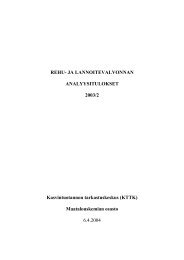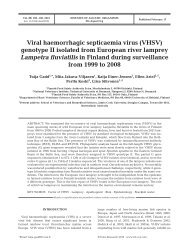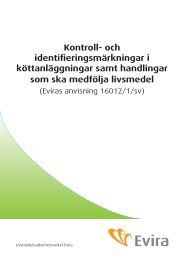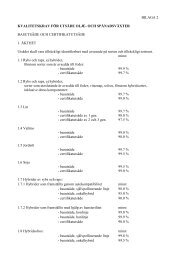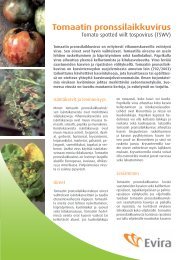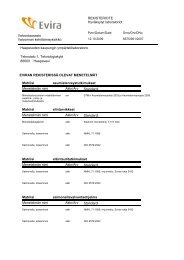Genetic characteristics of field and attenuated rabies viruses ... - Evira
Genetic characteristics of field and attenuated rabies viruses ... - Evira
Genetic characteristics of field and attenuated rabies viruses ... - Evira
Create successful ePaper yourself
Turn your PDF publications into a flip-book with our unique Google optimized e-Paper software.
(cDNA), followed by the amplification <strong>of</strong> the cDNA by PCR (Tordo et al., 1995, 1996).<br />
The RT-PCR procedure consists <strong>of</strong> the following steps: total RNA extraction,<br />
cDNA synthesis with r<strong>and</strong>om or specific primers, amplification <strong>of</strong> the cDNA with specific<br />
primers, <strong>and</strong> visualization <strong>of</strong> the results with horizontal electrophoresis in agarose gel<br />
containing ethidium bromide observed under UV light (Heaton et al., 1999).<br />
The RT-PCR is widely used for <strong>rabies</strong> diagnosis, <strong>and</strong> different parts <strong>of</strong> the genome<br />
can be targeted for this reason, but in most cases the N gene is utilized (Kulonen <strong>and</strong><br />
Boldina, 1993; Bourhy et al., 1999; Ito et al., 2003; Losa-Rubio et al., 2005). A rapid RT-<br />
PCR technique was developed for the detection <strong>of</strong> the classical <strong>rabies</strong> virus (genotype 1)<br />
<strong>and</strong> the <strong>rabies</strong> related EBLVs (genotypes 5 <strong>and</strong> 6), <strong>and</strong> also to distinguish between the<br />
six established <strong>rabies</strong> <strong>and</strong> <strong>rabies</strong>-related virus genotypes (Black et al., 2000, 2002). The<br />
PCR can also be applied to detect the <strong>rabies</strong> virus genome in formalin-fixed paraffinembedded<br />
brain tissue (Kulonen et al., 1999) <strong>and</strong> for the intravitam diagnosis <strong>of</strong> <strong>rabies</strong> in<br />
humans by testing saliva <strong>and</strong> cerebrospinal fluid (Crepin et al., 1998). The Real-time<br />
PCR is a quantitative technique which allows the detection <strong>of</strong> an increase in the amount<br />
<strong>of</strong> DNA (cDNA) during amplification. It is currently used for the ante- <strong>and</strong> post-mortem<br />
diagnosis <strong>of</strong> <strong>rabies</strong> <strong>and</strong> the discrimination <strong>of</strong> the Lyssavirus genotypes (Wakeley et al.,<br />
2005; Nagaraj et al., 2006; Saengseesom et al., 2007).<br />
1.4.3. Virus isolation<br />
The mouse inoculation test (MIT) was one <strong>of</strong> the first diagnostic tests for <strong>rabies</strong>.<br />
Laboratory mice are inoculated intracerebrally or subcutaneously with the supernatant <strong>of</strong><br />
the sample suspension. The inoculated mice must be observed for up to 30 days after<br />
inoculation. Death during the first 48 hours after inoculation must be considered as nonspecific;<br />
all the animals dead after this period must be dissected <strong>and</strong> brain samples must<br />
be tested for <strong>rabies</strong> by the FAT (Koprowski, 1996). This method can be used for testing<br />
the brain <strong>and</strong> salivary gl<strong>and</strong> suspensions, as well as the saliva samples, for the presence<br />
<strong>of</strong> live <strong>rabies</strong> virus (Adeiga <strong>and</strong> Audu, 1996; Delpietro et al., 2001).<br />
The cell culture inoculation test has already replaced the MIT in many countries<br />
<strong>and</strong> implies the isolation <strong>of</strong> <strong>rabies</strong> virus in a cell culture monolayer with visualization by<br />
the FAT. A number <strong>of</strong> cell lines have been selected <strong>and</strong> tested: cow brain cells (CB3),<br />
cerebral <strong>and</strong> cerebellar grey matter cells <strong>of</strong> mice (MBC-2, MBC-3), chicken embryo<br />
fibroblasts (CEF), murine, feline <strong>and</strong> human glial cultures, human monocytic U937 <strong>and</strong><br />
THP-1 cells, murine macrophage IC-21, murine monocytic WEHI-3BD- <strong>and</strong> PU5-1R<br />
19



